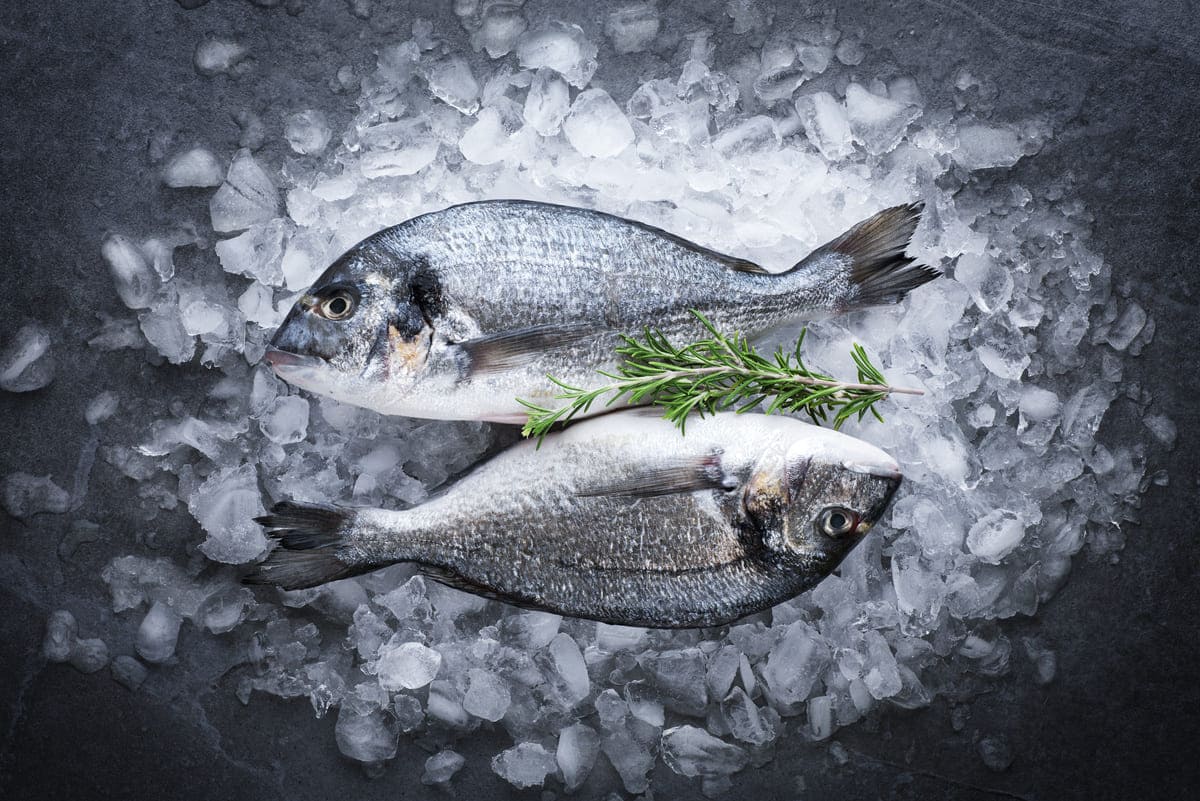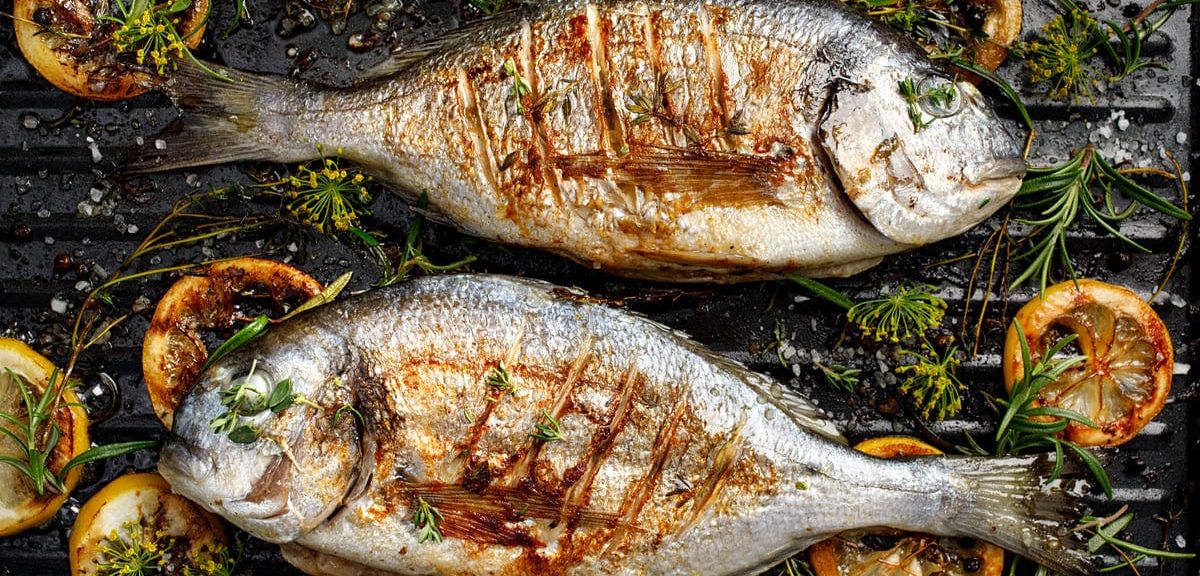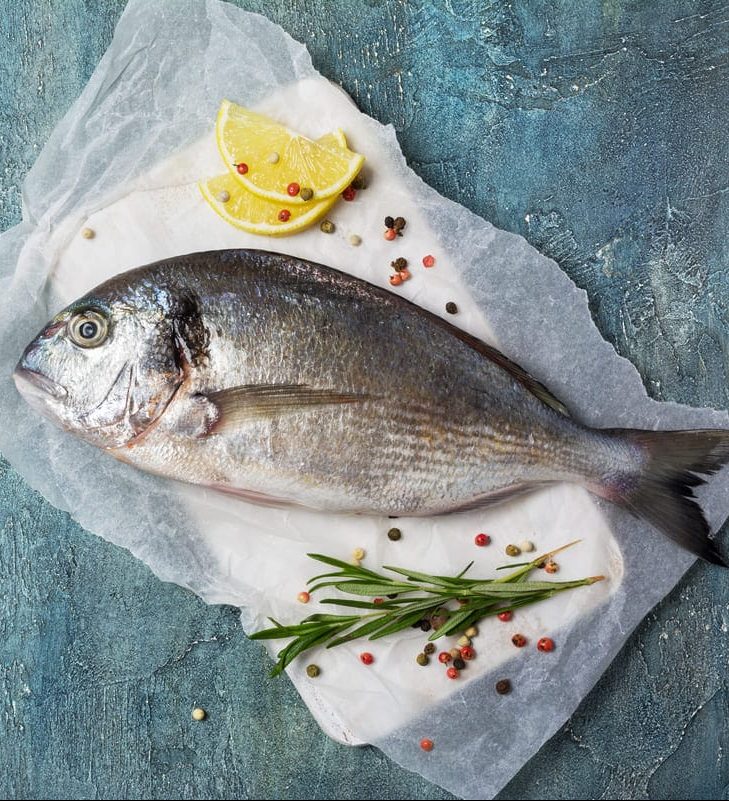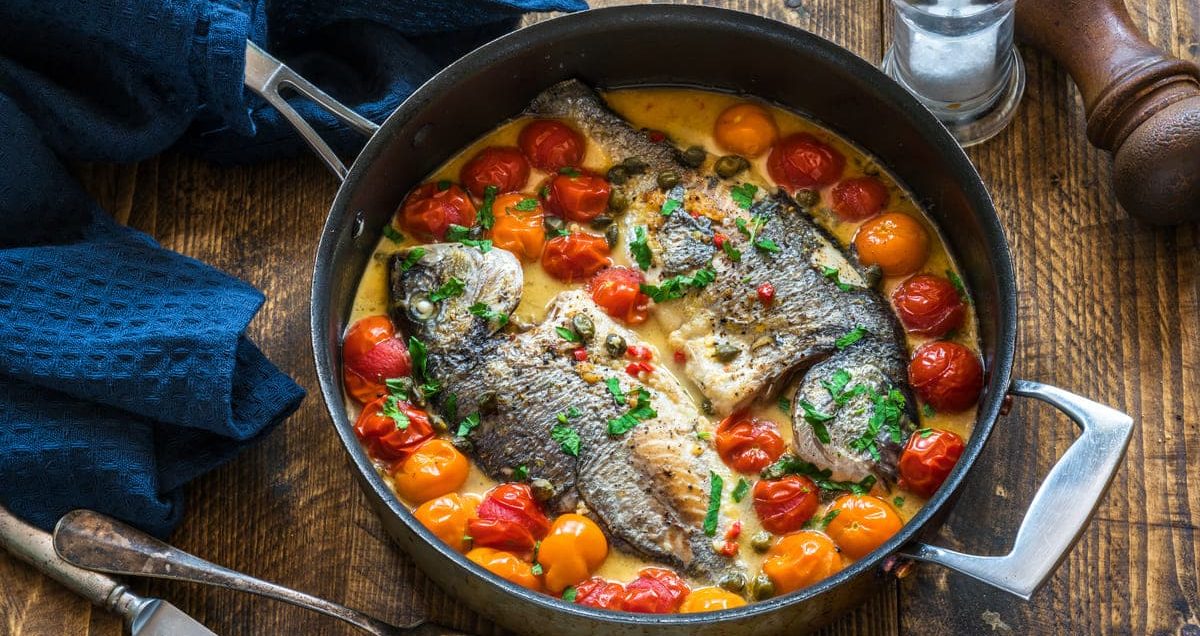
Introduction
Sea Bream, or Pagrus auratus, is an extremely popular fish species found and consumed around the world. It comprises six species, famous for recreational sport fishing, edible, and economically significant throughout the Mediterranean and eastern Atlantic Ocean.
Highly valued for its flavour and versatility when cooking, sea bream can be grilled, baked, pan-fried or roasted, making it an ideal accompaniment to various dishes. While traditionally used in Mediterranean cuisines such as Spanish and Greek, sea bream is now gaining traction amongst other countries.
This family of fish is highly valued due to its firm texture and flavorful taste, making it a popular option for home cooks and professional chefs.
Description
Sea Bream are bony fish found in many warm and temperate seas worldwide. They are a species of fish belonging to the family Sparidae.
The European sea bream is the most common type (Sparus aurata). Commonly known as the ‘common sea bream’, its scientific name is derived from the Latin words ‘sparus’ meaning ‘spotted or speckled’, and ‘aurata’ meaning ‘gilded’ about the gold patches on its dorsal fin.
Apart from the European sea bream, other types of sea bream include the Japanese sea bream (tai) and the South African common sea bream (Chrysoblephus puniceus).
Sea breams are an essential part of marine ecosystems. They are apex predators at the top of the food chain, acting as coastal lions by controlling abundant invertebrates and fish populations. They are also primary consumers, foraging for foods such as planktonic crustaceans, polychaetes, benthic proteins, bivalves, polychaetes, shrimps, fish, and jellyfish.
Additionally, sea breams are scavengers that regularly consume dead organisms or other inorganic material. Due to this, sea bream play a significant role in the food chain as primary and secondary consumers, providing an important food source for many larger predatory species. They are also essential in maintaining coastal ecosystems and regulating abundant populations of invertebrates and fish.
Physical Characteristics
Sea Bream possess an eel-like shaped fin structure with a long, slender anterior profile. Additionally, their dorsal fin has 10-14 spines, and the anal fin has 8-12 rays. The pelvic fin has one spine and five rays, while the pectoral fin has 15-17 rays and a black border. The lateral line usually contains 35-45 scales. Finally, the caudal fin is deeply forked and has a wide base. Along with their fins, they also have two symmetrical pectoral fins and two symmetrical pelvic fins.
They have distinctive torpedo-shaped bodies laterally compressed, a large head, and a broad, slightly flattened face.
Sea Bream come in various colours, from silver and bluish-green to beige and yellowish or golden. Their dorsal part is typically darker than the ventral part and may display blue or greenish stripes along the back.

Habitat and Distribution
Sea bream can be found in waters across the globe, from tropical to temperate regions, typically near the coastline or in shallow waters, tide pools, and rocky environments. They inhabit many habitats, from coral reefs and estuaries to rocky crevices, kelp forests, and estuaries.
Sea bream species are found in many areas of the world, particularly in the Mediterranean Sea, the North-East Atlantic, and the South-Western Atlantic. As sea bream play a critical role in the ocean’s ecosystem, the sustainability of sea bream fisheries is taken very seriously.
Sea Bream Fisheries
Seabreams are integral in many coastal and offshore fisheries for domestic subsistence and commercial uses. Highly valued for their delicate and tasty meat, these species are used widely for human consumption and aquaculture purposes due to their fast growth and breeding potential. They are also used as food for other fish species.
Monitoring of Wild Sea Bream Populations
Wild sea bream populations can be monitored through various methods, including acoustic surveys of trawling activity, optically-based methods such as otter trawling, hydroacoustic surveys, mark-recapture experiments and biochemical sampling.
Catch quotas and length restrictions are essential in managing and controlling fishing to reduce bycatch and protect against overfishing.
Alternative harvesting methods, such as hand lines and traps, can reduce bycatch and extend the fish’s life expectancy in the wild.
Sustainable Management of Sea Bream Fisheries
Regulations and policies have been established to protect sea bream from overfishing. These include the European Union Fisheries Common Policy, the North East Atlantic Fisheries Commission, and the South Western Atlantic Fisheries Commission. Internationally, the United Nations Food and Agriculture Organisation and the International Council for the Exploration of the Sea have set catch limits for sea bream to encourage sustainable fishing practices.
Furthermore, countries and regions have implemented regulations, such as the United Kingdom banning trawling for sea bream and the Mediterranean Sea’s restrictions on trawling.
Strict catch limits have been imposed to ensure that extractions of wild sea breams are sustainable. All sea bream anglers must adhere to several rules, including gear/fishing restrictions, closed areas, closed seasons and gear/vessel restrictions.
Marine Protected Areas (MPAs), specifically for sea bream species, are also established to protect the fish and its habitat. Surveillance and monitoring are in place to detect illegal, unreported and unregulated fishing. The FAO Code of Conduct for Responsible Fisheries is also followed to ensure that sea bream fisheries are managed sustainably.
Life Cycle of Sea Bream
The life cycle of sea bream typically lasts 2-3 years. The life cycle consists of eggs, larvae, juveniles, sub-adults and adult stages. The eggs are usually laid in shallow coastal waters (1-10 meters deep). The larvae generally remain in the surface waters for a few weeks before settling in nearshore areas.
Juveniles then move into deeper waters as they mature and reach a size of 6 to 8 centimetres in length. Sub-adults regularly migrate to shallow areas to feed and spawn. At the same time, the adult phase is characterised by migration from shallow coastal waters to deeper coastal waters, where spawning occurs. Changes in behaviour and diet are observed as the fish progress from one life stage to the next.
Sea breams reproduce by spawning when temperatures reach several degrees above the yearly average and when decadal shifts in water temperature are noticed. Their spawning season is generally longer in the Mediterranean and the Black Sea, lasting from spring to early autumn.
Classification
The scientific classification of sea bream includes Kingdom: Animalia; Phylum: Chordata; Class: Actinopterygii; Order: Perciformes; Family: Sparidae; and Genus: Sparus, Diplodus, Pagrus, Chrysophrys, Argyrops, Evynnis, and Acanthopagrus.
Sea bream can be classified between four and seven different genera depending on the species. The common varieties of sea bream include black banded, yellowfin, theadfin, pagre, porgy, dentex, gilthead and ray’s bream.

Sea Bream’s Diet
Sea breams are omnivorous and feed on a range of both animal and plant material. They primarily feed on zooplankton and benthic invertebrates such as molluscs, crustaceans, and worms. Small fish like sardines, mackerel, herring, and anchovies are also part of their diet.
Sea bream will also consume algae, seagrass, detritus, small insects, larvae, eggs, and fry. In captivity, they may also eat pellets or other processed food.
Economic and Ecological Significance
Sea Bream are important economically due to their commercial value as a seafood option, their use in aquaculture, and their contribution to fish stocks. They are commercially significant as they provide a valuable food source and income for many anglers and fish producers worldwide.
They are even sought after in game fishing, such as black and red sea bream.
Additionally, the roe from these fish is a valuable source of caviar, which adds to their economic worth.
Ecologically, sea breams are equally important; they are a vital keystone species, serving as predators and prey in the food chain. They provide food for many predators, granting them importance in marine habitats.
Nutritional Values
Compared to other types of fish, Sea Bream is higher in fat and saturated fat and lower in omega-3 fatty acids than whitefish species like cod and haddock.
Sea Bream is an excellent energy source and essential vitamins and minerals, including calcium, phosphorus, selenium, and Vitamin D. It is also exceptionally high in B vitamins such as thiamine, riboflavin, and niacin.
Sea Bream contains Astaxanthin, an important antioxidant linked to improved heart health and reduced inflammation.
Health Benefits
The nutrients found in Sea Bream offer many health benefits. Omega-3 fatty acids are essential for heart health, development and brain health, while vitamin B12 helps with red blood cell formation and plays a role in the metabolism of fats, carbohydrates, and proteins.
Selenium plays a role in thyroid functioning and is an important antioxidant, and magnesium aids nerve and muscle functioning. Additionally, zinc helps with the absorption of other essential nutrients.
Taste, Flavor, and Seasoning
Sea bream has a mild, sweet, nutty flavour and a firm texture. Its flavour is comparable to white flesh fish dishes, such as cod, sea bass, haddock, snapper, salmon, and pike.
The flavour of sea bream can be further enhanced by adding citrus, spices, herbs, and different sauces. It is usually seasoned with chilli powder, garlic powder, lemon, black pepper, smoked paprika, or other herbs and spices and cooked in butter or oil to improve its flavour and texture.
Cooking Sea Bream
Sea bream is a highly versatile fish that can be cooked in various ways. To cook sea bream, its flavour lends well to grilling, baking, steaming, or pan frying. When prepping a sea bream for cooking, look for its clear and vibrant skin, bright eyes, and mild odour. The fish will be fresh if this is the case.
Pairing Ingredient Ideas
Sea bream has delicate flavours, so acidic ingredients like capers, lemons, limes, and vinegar are often used to bring out the taste of the fish.
Popular side dishes that pair well with sea bream are potatoes, leafy greens, mushrooms, tomatoes, onions, garlic, and other citrus fruits. Herbs and spices like parsley, oregano, dill, rosemary, basil, tarragon, nutmeg, and cumin can help bring out the richness of the flavour of the fish. Olives (black, green, or Kalamata) can give the dish a briny, earthy flavour.
Fresh vegetables and fruits such as tomatoes, zucchini, peppers, oranges, and lemon pair well with sea bream. When it comes to cooked sides, starchy items like couscous, potatoes, rice, or pasta, as well as sauces and dressings such as a Mediterranean-style vinaigrette, tomato sauce, pesto, or an emulsified sauce, are all excellent accompaniments.
Perfect Drink Pairings
The mild yet salty and slightly sweet taste of sea bream can be perfectly complemented with a full-bodied white wine like chardonnay, pinot grigio, or sauvignon blanc. Sea bream dishes can be enhanced by this and by the accompaniments and side dishes.

Popular Recipes
There are numerous great recipes online for using whole sea bream or sea bream fillets in different ways. Whether you are looking for an appetiser or an entrée, the mild flavour of sea bream makes it a great accompaniment to various sauces and herbs. Incorporating sea bream into your cooking is an easy, nutritious and delicious way to enjoy this whole fish.
Popular recipes featuring sea bream include Baked Sea Bream with Fennel, Lemon and Basil; Grilled Sea Bream Wrapped in Prosciutto; Grilled Sea Bream with Olives, Tomatoes and Parsley; Spicy Miso Glazed Sea Bream; and Sea Bream with Orzo and Tomatoes.
There are a variety of dishes for sea bream that are not limited to Mediterranean cuisine, including Spanish Grilled Sea Bream with Paprika, Portuguese Baked Sea Bream with Figs and Onions, Fried Bream with Ginger and Shallot Dressing and Cajun Grilled Fish Tacos with Sea Bream.
Cultural and Culinary Similarities/ Cultural uses
In addition to its culinary popularity, sea bream also holds significant cultural importance in certain societies.
In Japan, sea bream is traditionally seen as a gentle and kind fish and a symbol of good luck and recovery. Similarly, in China, eating fish sea bream is featured in old folklore tales and is thought to bring fortune and prosperity. Due to its strong cultural relevance, sea bream has a special place in many cultures.
Conclusion
In conclusion, sea bream is a multi-faceted species deemed necessary in commercial and ecological contexts. Their diverse range, delicious taste, and high marketability make sea bream an important option worldwide. Growing demand for responsible and sustainable seafood drives the need for responsible management of these species to ensure their protection and conservation.